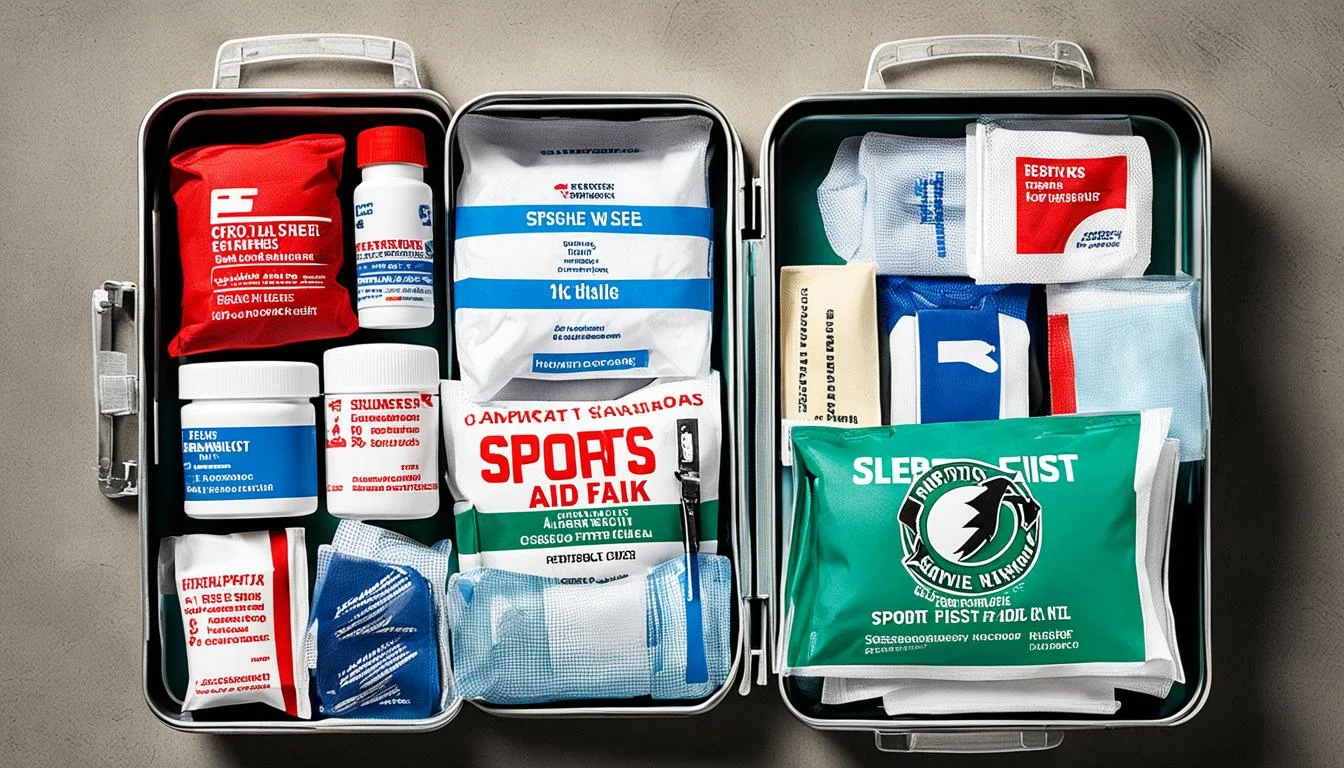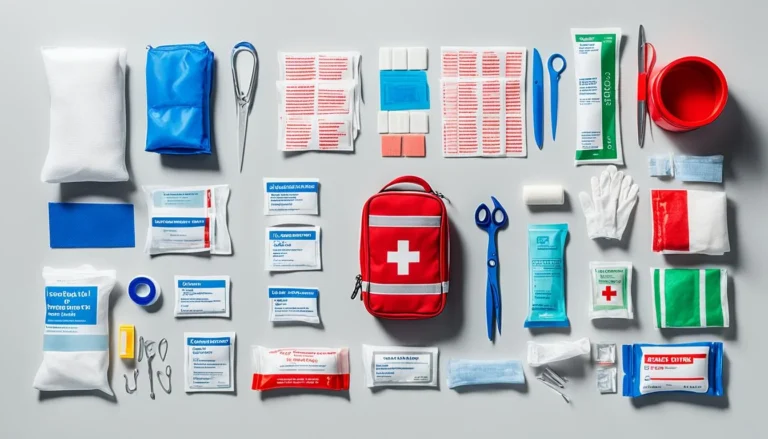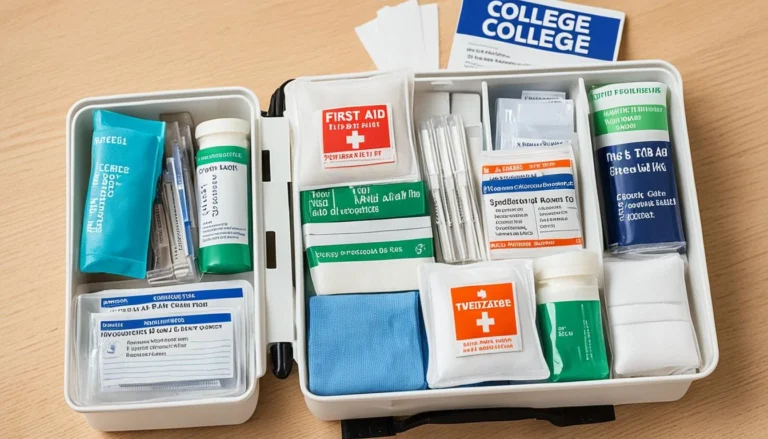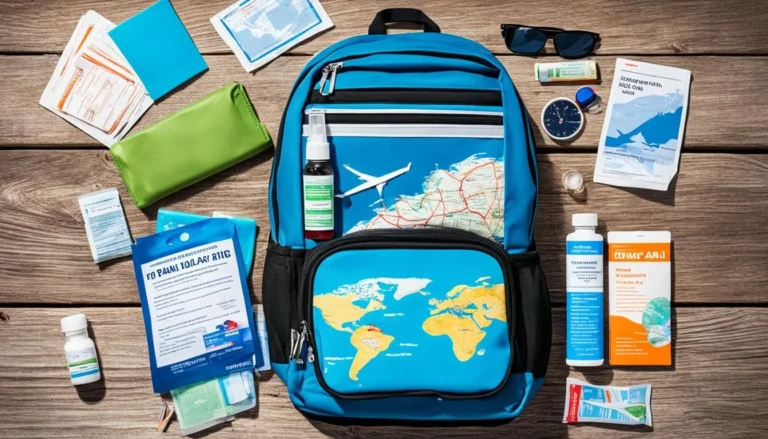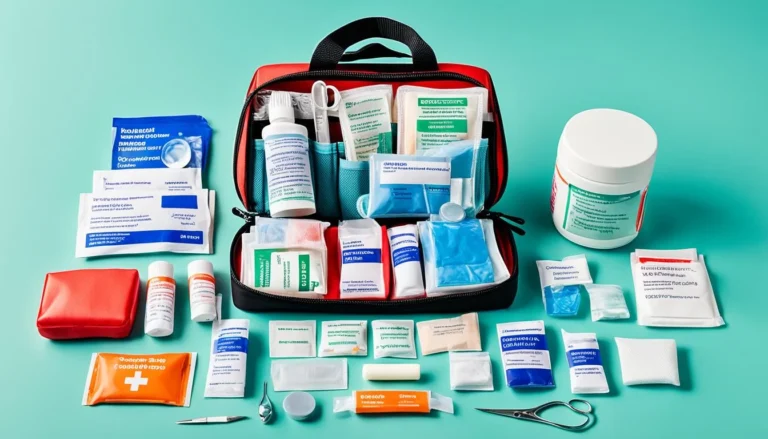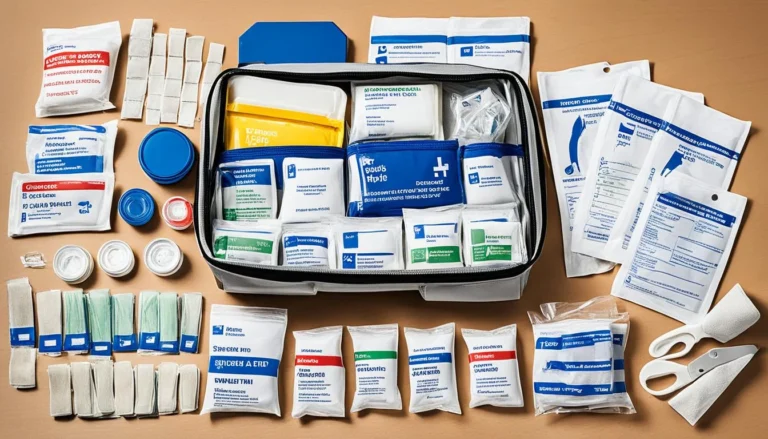Essential Guide: What Is A First Aid Kit Explained
It might surprise you, but in the UK, millions of accidents happen at home each year. This is a serious thing and shows us how important having a first aid kit is. It’s not just a box with bandages. A first aid kit helps us respond quickly in an emergency. It has supplies that can act fast and prevent minor issues from becoming serious.
Knowing what a first aid kit is and why it’s important is a sign of wisdom. It’s also a legal must in many cases. First aid kits should be in homes, schools, cars, and workplaces. Without one, you’re not ready to face accidents, whether small or big. In this guide, we’ll cover what you need in a first aid kit. The goal is to help you understand how crucial it is for emergencies. This is the start of your journey to being prepared for any medical emergency.
Key Takeaways
- First aid kits are crucial for immediate treatment of minor injuries and stabilising serious conditions.
- Having a first aid kit contributes to emergency preparedness in domestic, educational, vehicular, and professional environments.
- Emergency kits are composed of a variety of medical supplies catering to different kinds of injuries.
- Effective organisation and management of first aid materials is essential for quick and hygienic medical response.
- Compliance with safety regulations often necessitates maintaining a well-stocked and accessible first aid kit in workplace spaces.
Understanding the Importance of a First Aid Kit
In the world of workplace safety, a proper first aid kit is not a nice-to-have. It’s crucial. It meets Health and Safety regulations and helps with quick emergency response and injury treatment. These kits are key in reducing the harm from injuries. This saves lives and cuts down on healing time.
A first aid kit is vital before expert medical help comes. It boosts safety at work. It makes sure any accident, big or small, gets treated fast and right. This keeps workers safe and keeps the company following the law.
- Immediate treatment of cuts, burns, and other injuries
- Less risk of infection and less severe injuries
- Following safety rules at work
A well-kept first aid kit matters a lot. It doesn’t just meet rules and make work safer. It’s the first help against dangers at work. It makes everyone feel protected and looked after. In any case, from small hurts to big emergencies, having a first aid kit nearby helps a lot.
The Core Components of a Standard First Aid Kit
A well-stocked first aid kit is key for good wound care and treating eye injuries. Inside are many medical dressings that help with different injuries.
Assortment of Wound Dressings
In every first aid kit, there’s a variety of wound dressings. These help with cuts and scrapes of all sizes. For minor injuries, you’ll need hypoallergenic and water-resistant plasters.
Sterile Low Adherent and Eye Pad Dressings
Some dressings are specifically designed not to stick to wounds. This helps prevent infections on those wounds. Eye pad dressings are there to take care of eye injuries specifically.
Burn Dressings and Sterile Finger Dressings
Burn dressings contain cooling gels for pain relief and quicker healing. There are also dressings made for finger injuries. They don’t get in the way of using your fingers while they heal.
| Type of Dressing | Usage | Features |
|---|---|---|
| Plasters | Minor Cuts and Grazes | Hypoallergenic, Water-resistant |
| Sterile Low Adherent Pads | High-risk infection wounds | Prevents adherence, Sterile |
| Eye Pad Dressings | Eye Protection | Sterile, Protective |
| Burn Dressings | Burn-related injuries | Cooling gel, Pain relief |
| Sterile Finger Dressings | Finger wounds | Flexible, Sterile |
What Is A First Aid Kit Specifically Used For?
A first aid kit is crucial for emergency care and treating minor injuries. It’s the first help you give for cuts, scrapes, or more serious injuries. It helps until you get to a doctor or healthcare worker.
Wound management is a big part of what a first aid kit does. It’s important to treat wounds right away. Cleaning and dressing the wound helps stop infections and heals them faster, especially when medical help is far.
- Application of sterile bandages to prevent infection.
- Use of antiseptics to clean wounds thoroughly.
- Employment of ice packs to manage swelling and reduce pain.
A first aid kit also helps keep caring for someone. It has items to protect the person giving help, like gloves and masks. So, it’s important for the one who needs help and the one offering it.
In the end, a first aid kit does more than provide quick help. It protects and saves lives when time is of the essence.
Organising Your First Aid Supplies for Rapid Response
Good first aid kit organisation is key. It makes sure help is fast during emergencies. A well-prepared kit lets you grab equipment quickly and be ready for anything unexpected.
Optimising Layout for Quick Accessibility
For emergency preparedness, organise your first aid kit well. This means important items are always easy to spot. Group items by use and how often they’re needed. This can be a big help in critical moments.
- Bandages and dressings should be at the top for fast use.
- Sort medications by their names.
- Keep tools like scissors and tweezers in their own place.

Keeping Supplies Hygienic and Ready for Use
Looking after your kit is vital. It must stay clean and updated. This keeps medical equipment accessibility at its best.
- Check expiry dates often and swap out soon-to-expire or used items.
- Keep everything dry and sealed as needed.
- Clean the kit and top up items regularly.
Following these tips boosts your emergency preparedness. It ensures your kit is always ready to be a big help when needed.
Placement and Storage of First Aid Kits
Storing your first aid kit correctly is key. This ensures it’s easy to reach and quick to use in emergencies. Putting first aid kits in the right spot makes help ready right away, whether at home, work, or public places.
Options for Worktop, Cabinet, and Wall-Mounted Kits
It’s smart to keep first aid kits where they can be seen and grabbed easily. Wall-mounted kits in public areas are very visible. For smaller places or at home, cabinets and worktops are perfect. They keep your supplies out of sight but still handy.
The Pros and Cons of Portable versus Fixed Stations
Deciding on portable or fixed first aid stations depends on where you are. Portable kits can move with you in fast-changing places. This is great when you need supplies everywhere. But, in places where emergencies happen in the same spot, fixed stations work well. They offer a set place for help, which can be faster in certain situations.
First Aid Equipment for Workplaces: Ensuring Compliance
Making sure workplace safety is top-notch is a big legal deal. In the UK, employers must stick to the rules carefully. They have to make sure their workplaces are ready for any medical emergency. This includes having the right first aid stuff and teaching their workers how to help with health problems.
Good health and safety plans need to cover everything from small to big health issues. It’s important that these rules are not just made but are clear and easy to get to. This helps make work a safe place for everyone.
- Proper first aid supplies and equipment ready for immediate use.
- Regularly updated training sessions for staff on how to use the first aid equipment competently.
- Clear signage and information on first aid procedures and the location of first aid kits.
| Requirement | Description | Compliance Check |
|---|---|---|
| First Aid Kits | Ensure kits are stocked and accessible in all relevant areas | Quarterly Review |
| Trained Personnel | Staff trained in first aid basics, CPR and emergency response | Annual Training |
| Documentation | Proper recording and documentation of any incidents | Mandatory Reporting |
Falling in line with the Health and Safety (First Aid) Regulations 1981 is a must. It’s about more than just following rules. It’s key for keeping a safe culture. This cuts down on accidents and makes help come faster during bad times.
So, having a good safety and first aid plan makes everyone feel safer at work. It shows that safety is really important. And it makes sure help is always close by if there’s an emergency.
Types of Containers for First Aid Kits
It’s vital to pick the right first aid kit container. This choice helps with neatness and makes sure the supplies are easy to get to quickly. Different containers for first aid kits affect how fast and well we can respond in an urgent situation.
The Benefits of Hard Shell vs Soft Case Containers
Hard shell containers are great when things need to be tough. They keep supplies safe from drops, bumps, and rough conditions. These are good for places like factories or for adventures outside. On the flip side, soft case containers are light and easy to carry. They are perfect for your own first aid kits that you might keep in a car or a desk, making your supplies reachable when needed.
First Aid Kit Stations and Wall Brackets
In work areas, having first aid kits on walls is smart for quick use. They make it easy to see and grab them fast. Plus, they are placed strategically to help everyone get help in an emergency. This is a big help in keeping emergency supplies close and ready.
Knowing about different first aid kit containers leads to making better choices. This, in turn, helps us respond well and quickly in times of need.
Essential Items for Infection Control in Emergency Situations
Infection control is vital in an emergency to stop pathogen spread and keep patients safe. Hygiene in first aid lowers the risk of infection when treating injuries. High cleanliness and safety levels are maintained by using specific items.
Disposable Gloves and Sterile Saline Wipes
Disposable gloves are key for protection. They stop direct touch with blood and fluids, cutting the risk of spreading germs. Sterile saline wipes are also crucial. They clean wounds safely, ensuring no new harm is done, and help wounds heal better.
Hand Sanitiser and Saline Wound Wash
Hand sanitisers are essential for keeping hands clean when water and soap aren’t near. They’re important for treating wounds or touching any first aid supplies. Saline wound wash is gentle but effective for cleaning wounds right after they happen, removing debris and dirt.
All these products are vital for strong infection control in first aid.

The Fit for Purpose First Aid Kit: Tailoring to Your Needs
Keeping everyone safe is vital, especially with the right custom first aid kits. They are made to fit different specific industry needs perfectly. These kits have exactly what’s needed for their setting, be it a busy kitchen or a small vehicle.
Customising Kits for Homes, Vehicles, and Businesses
No two places are the same, so each first aid kit should be different too. In your home, you might need more supplies for kids, but in a car, they must be small and tough. Businesses in risky places get first aid kits that deal with their special dangers.
Special Considerations for Food Handling and Warehouses
Places like restaurants need first aid supplies that follow strict food safety rules. That’s why they use blue plasters that can be seen if they fall in food. Warehouses, with their big machinery, need kits for cuts and moving heavy things. They also must have clear signs showing where to find help fast.
| Environment | Considerations | Kit Customisations |
|---|---|---|
| Home | Family-oriented, child safety | Paediatric items, burn creams, antiseptics |
| Vehicle | Compact, heat-resistant, secure storage | Break-resistant containers, emergency road aids |
| Business (General) | Employee numbers, potential hazards | Industry-specific items, high quantity supplies |
| Food Handling | Compliance with food safety laws | Detectable plasters, burns treatments |
| Warehouse | Large scale, mechanical risks | Heavy duty bandages, splints, signage |
Conclusion
Having a well-built first aid kit is key for staying safe in medical emergencies. This article shows why they are crucial for being ready for when accidents happen. First aid kits are essential, whether you’re at home, work, or on the road. They provide what’s needed for specific situations and are vital tools, not just extras.
The value of a first aid kit goes beyond its items. It’s about being prepared to help in an emergency. This tells a lot about caring for health and safety. It means sticking to safety rules and looking out for people’s well-being. Choosing and looking after these kits is a core part of taking care of others.
Being ready for an emergency could make all the difference, especially when time is tight. Knowing about first aid kits and how to use them is a sign of caring for the community. It’s a call for us all to work together to decrease risks and keep everyone safe. It’s not just about having the right tools. It’s about being aware and getting ready for the unexpected.

